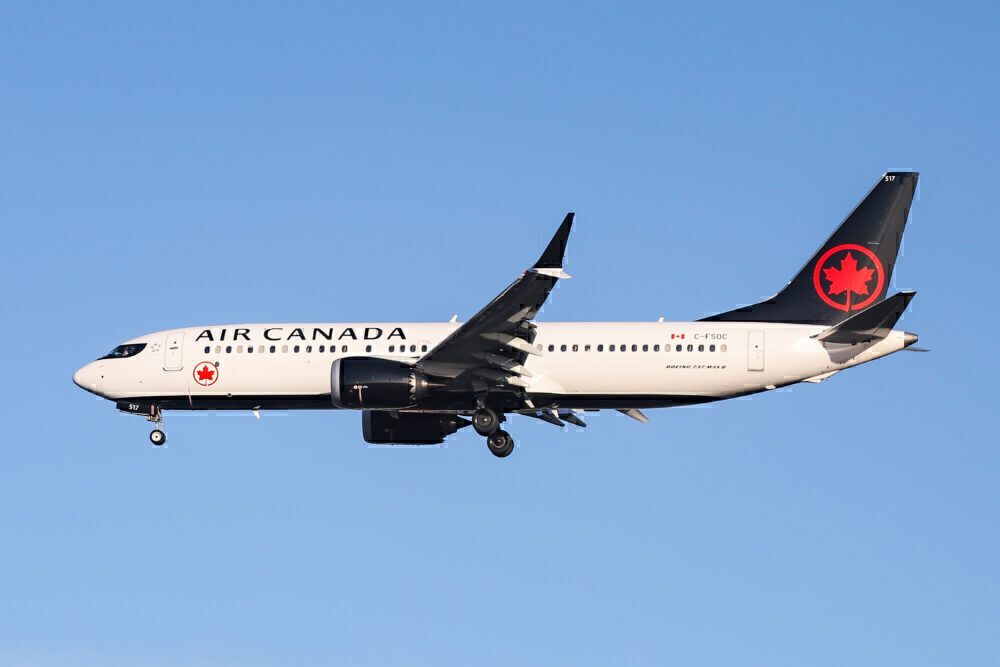
Air Canada Boeing 737 MAX Suffers Engine Fault On Ferry Flight
by Linnea Ahlgren
December 25, 2020
While on a ferry flight from the Sonoran Desert to Quebec on Tuesday, an Air Canada Boeing 737 MAX 8 declared urgency following indications of low pressure in the left engine and subsequent fuel imbalance from the left wing’s tank. The aircraft diverted to Tucson and landed without incident one hour and 20 minutes after departure.

An Air Canada 737 MAX diverted to Tuscon while on a ferry flight to Montreal on Tuesday. Photo: Getty Images
The crew decided to shut the engine down and divert
On December 22nd, an Air Canada 737 MAX was on its way from long-term storage at Pinal Airpark (MZJ) in Marana, Arizona, to Montreal in Quebec when two connected incidents caused its diversion to Tucson instead.
Flight AC2358 departed from MZJ at 09:32 local time with three crew on board. A short while after take-off, the pilots received a hydraulic low-pressure indication from the left engine.
The crew worked the check-lists and after consultation with dispatch and maintenance, they decided to continue to Canada and Montréal–Trudeau International Airport (YUL). However, that was not the end of their woes, the Aviation Herald reports.
Shortly thereafter, at 39,000 feet, the left-hand wing tank indicated fuel imbalance. At this point, the cockpit crew decided to shut the left engine down. They also declared the international standard urgency signal; PAN-PAN. Rather than continue north, the pilots then turned back and diverted to Tucson International Airport (TUS).

The aircraft landed without incident and was escorted to a remote location by the airport’s emergency services. Photo: Getty Images
Returning after nearly a year in the desert
The MAX landed safely on TUS’s runway 11L about 80 minutes after departure. Emergency services met the aircraft on the taxiway. Following an initial inspection, they accompanied it to a remote position on the apron. At the time of writing, the plane was still in Tucson. The Transportation Safety Board of Canada (TSB) has said it would conduct an investigation of the incident.
The aircraft in question is a 737 MAX 8 registered as C-FSNQ. It arrived with Air Canada in June 2018. It was transferred to the dry Arizona desert for storage in February this year and joined shortly thereafter by nearly all of Air Canada’s MAXs to Only three, C-FSNU, C-GEIV and C-GEJL, have thus far returned from Arizona.

Air Canada recently sold nine of its 737 MAXs for leaseback.
Photo: Getty Images
The great MAX migration
The Canadian flag-carrier has a total of 24 MAX 8 jets already in its fleet. However, it has sold nine of them for leaseback in a bid for liquidity during the ongoing crisis. Meanwhile, the Star Alliance member is expecting delivery of another 14 of the aircraft.
Advertisement:
Boeing is underway to clearing its roster of ready but undelivered 737 MAX jets following the type’s recertification by the FAA a little over a month ago. However, one month following its ungrounding, only ten of the planes had made their way to their new owners.
While it appears to be unrelated to the software issues which caused the plane’s grounding, it is too early to say whether or not this incident will in any way impact Air Canada’s decision on when to bring the MAX back into service.
Simple Flying has reached out to the airline for a comment but was yet to receive a reply at the time of publication.

No comments:
Post a Comment